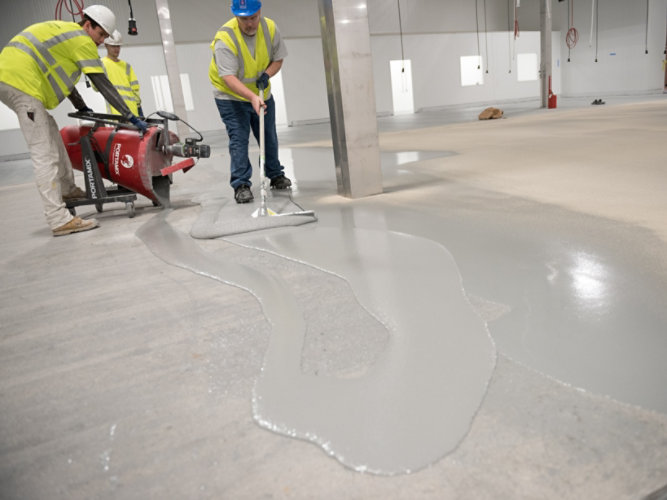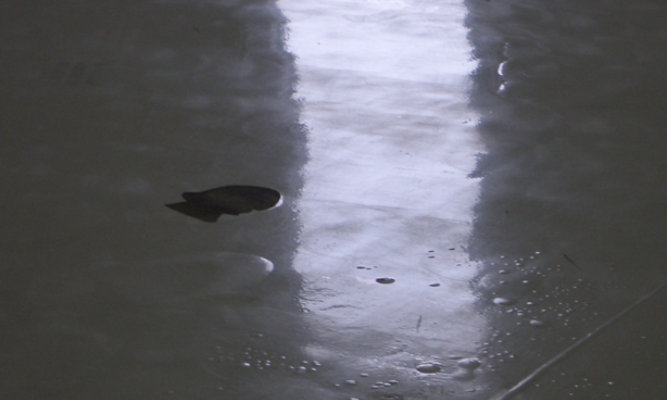Seamless Considerations for Selecting a Seamless Floor System
Understanding the resinous flooring market and the factors that have a bearing on flooring choice

When faced with the challenge of protecting a concrete floor, evaluating the potential options can be a rather daunting task. For more manageable decision making, break the process into sections to be addressed individually. Four factors that have a bearing on any flooring choice are performance characteristics, aesthetics, scheduling, and budgeting. After you understand these needs, the process of product selection is quite straightforward. Before examining each factor, it is appropriate to have an overview of the resinous flooring market.
What is a seamless floor?
A seamless floor contains no seams, expansion joints, or ridges. They are a poured flooring solution that creates a very functional and stylish finish. Floors are poured in place and can be made of epoxy, urethane, or methyl methacrylate formulations. Once poured, a seamless floor becomes a part of a the building structure.
Defining the seamless floor market
A simple way to grasp the complexity of the resinous flooring market is to consider a two-axis matrix. One axis defines the installation method and ultimately the thickness of the system. The second axis identifies the key elements associated with installation. Although these parameters hold true generally, the flooring chemistry required for the installation also affects overall cost and installation time.
Each installation has merits that specifically affect the performance, eye appeal, timing, and cost. The simplest system is a coating with the lowest cost and fastest installation but with the shortest expected useful life. Decorative aggregates cannot be used in coating applications, so the appearance is limited to solid colours. Generally, the low film build of this coating provides poor chemical, impact, and traffic resistance. An important issue to remember is that coatings do not hide imperfections in the substrate.
Seamless floor systems
Slurry based seamless flooring
A slurry system provides a thickness typically between 2 and 4 mm that holds up to most wheeled traffic and provides greater durability. However, the system takes longer to install than a coating and is more expensive. Incorporating an aggregate in the slurry imparts long-lasting skid inhibition.
Broadcast system flooring
Broadcast systems have the same attributes as slurry systems but use clear resins and decorative aggregates like coloured quartz. Including aggregate in both systems provides an inexpensive way to build thickness and skid resistance.
Mortar flooring systems
Mortar systems are reserved for applications that have the greatest chemical resistance, thermal shock resistance, and heavy duty traffic. They are also the system of choice to repair badly spalled, uneven, or sloped substrates. They generally are the most labour intensive systems to install and require the greatest installer skill. Decorative mortars have the same advantages as a solid colour mortar but, once again, they use a clear resin with decorative aggregate. These decorative mortars take the greatest skill to install because they frequently cannot be ground without altering the finished appearance.
Epoxy terrazzo flooring options
Epoxy terrazzo is used in areas that have heavy traffic, especially pedestrian, where aesthetics are one of the most important considerations. It has a high initial cost but maintenance costs are so low that the life cycle costs are quite favourable to other flooring options. This system has the most versatility in design, as both the resin and the aggregate can be changed. When chemical resistance is an important issue, use granite instead of marble aggregate and novolac epoxy instead of standard epoxy.
In general, system thickness, installation time, chemical resistance, cost, thermal shock resistance, and life expectancy increase as one moves from coatings, to self-levelling and to broadcast systems, to trowel applied floors, to epoxy or polyurethane terrazzo.
Each of these installation methods use a variety of chemistries. The properties that the chemistry controls are chemical resistance, adhesion, mechanical properties such as tensile and compressive strength, weatherability, shrinkage, and speed of cure.
After understanding the performance parameters, use this matrix to ensure using the correct chemistry and installation method. Of course, suppliers and installers of these types of systems are an invaluable asset in the selection process. Now, let’s look at the specifics in each of these areas.
Seamless flooring performance
The single most important variable in selecting an appropriate floor topping is defining the right performance. There are more unhappy floor owners through selecting the wrong system than for any other reason, this should be considered the leading cause of any dissatisfaction, and it’s the reason that accurate and realistic advice being provided is essential. The key performance parameters include chemical exposure, traffic conditions, wet or dry environment, UV exposure, maintenance regime, and the substrate condition.
Chemical resistance
In general, the thicker the system, the better the chemical resistance. This follows simple logic in that it takes longer for chemicals to react through a thicker flooring than a simple coating. Of far greater importance is selecting the right chemistry such as epoxy, polyurethane, polyaspartic or vinyl ester systems
Also, many chemicals in the plant react with other spilled chemicals to create a hazard far greater than either of the reactants. Understand the possible interactions could occur to ensure chosen the right product. Most reputable suppliers test resistance properties of the flooring products and are more than willing to provide this information.
Traffic conditions
Traffic and expected use and abuse are important considerations. Use of steel wheeled vehicles versus rubber wheeled vehicles affects the choice of aggregate, chemistry, and application method. Couple this with high impact from a production area and perhaps you would make a different selection.
New technology based on epoxy elastomers provides excellent impact and crack bridging capabilities for these types of problem areas. Flexible epoxies provide much better impact resistance and wear capabilities than the traditional 5 mm thick rigid trowel applied systems. In most facilities there are different traffic patterns that require different flooring systems. For example, aisles may receive the best system for heavy traffic, while work stations use a slurry or coating system. Battery recharging stations use a chemical resistant Novolac system. Judicious selection is a way to meet budgets and still get the best possible performance.
Four factors that have a bearing on any flooring choice are performance characteristics, aesthetics, scheduling, and budgeting.
Wet versus dry service
In wet service areas skid inhibition is a significant issue. The size and type of aggregate dictates the aggressiveness of the skid resistance in slurry and broadcast systems. Install a test patch to demonstrate the skid resistance of any system. Cleanability is inversely proportional to the amount of skid resistance. This is a decision that the floor users and the maintenance people should share before installation begins. Wet service may also demand a waterproof elastomeric epoxy membrane barrier to protect the substrate and any occupied space below. It is usually installed as an aggregate-free layer under the top layer. As an added benefit, this neat membrane serves as a crack bridging layer that protects the flooring system from slab movement.
Ultraviolet light resistance
Epoxies turn amber in the presence of ultraviolet light. Certain raw materials yellow more than others. Of the chemistries used in seamless systems, a two-component acrylic polyurethane offers the best possible resistance to UV light. These systems contain solvents and are generally used as a topcoat for various systems. While clear acrylic polyurethane systems shield some of the UV light, epoxy still yellows underneath the polyurethane. The broadcast systems with decorative aggregates generally perform better because the broadcast to excess leaves only a small amount of resin on the surface.
Maintenance regime
The maintenance regime is an important consideration when selecting a flooring system. Some cleaning agents contain strong oxidizing agents, strong acids, or strong bases. Checking with the maintenance department before selecting the flooring ensures a happy owner. Because skid resistance dramatically alters cleanability, the concerned parties should agree to the level of skid resistance.
Substrate condition
The substrate condition greatly affects system choice. For every system except coatings, the preferred method of surface preparation is an abrasive vacuum blast. The condition of the concrete affects the surface profile. For example, if the base cement has a very high water-cement ratio, then the surface will probably effloresce and be weak. An aggressive shot blast creates a much deeper profile than the same blast on sound concrete. In this case, or in the case of badly spalled concrete, a slurry or broadcast system may not hide the entire profile.
Another substrate issue is the water content of the concrete. The concrete should not have more than 3 percent moisture (by weight) or release more than 3 pounds of water per 24 hours per 1,000 square feet. Exceeding these limits exposes you to the risk of future bonding problems. Check with your material supplier for a recommendation if this is the case.
Seamless foor textures and aesthetics
As outlined above, some performance characteristics limit the decorative options available. After first identifying the type of floor systems and required base chemistries, address aesthetic parameters. Often this means simply choosing the desired colour or using different colours to define traffic areas. Using different colours through the depth of the system is an easy way to judge wear and schedule maintenance.
When considering aesthetics, your options include colour, design, gloss rating, and finish texture. Not all chemistries are available in all colours. If safety and chemical resistance are the primary consideration, colour and aesthetics are less of an issue. On the other hand, standard seamless flooring products are virtually unlimited in design characteristics. Pigmenting the epoxy matrix or using a clear matrix with coloured aggregate achieves any flooring colour. Combining these options allows for a variety of different finishes that can be manufactured to match any colour desired.
The use of colour and design is most dramatically illustrated in thin-set epoxy terrazzo. Coloured aggregates with an epoxy matrix yields a limitless colour selection and divider strips form pictures and patterns. Other trowel applied decorative flooring systems also use divider strips for colour patterns and designs.
The use of colour and design is most dramatically illustrated in thin-set epoxy terrazzo.
Scheduling and installation of seamless flooring
Timing and scheduling the installation may impact the systems available for selection. There are some chemistries that allow for quick installation. Others require cure times of up to one week to achieve full chemical and mechanical resistance. Most epoxy and polyurethane systems require the concrete to be at least 30 days old before installation because these products will not allow excess moisture to escape from the concrete. Consider also the work schedules of existing operations and other trades during new construction.
Some of the fastest setting polymers are methylmethacrylates, Novolac epoxies, vinyl esters, and polyureas. Each provides unique advantages but may have other drawbacks. Methylmethacrylate, for example, has a strong odor, is sensitive to water that terminates the polymerization reaction, and is high in relative cost. Similar to methylmethacrylates, vinyl esters use a free radical reaction that is sensitive to moisture and have a pungent odour. Polyurea exhibits excellent elongation but in general has lower adhesion properties relative to epoxy. Novolac polymers have a high degree of cross-linking that gives excellent chemical resistance but does not achieve full chemical resistance for up to seven days. It has a tendency to chalk and discolour when exposed to UV light. Epoxies can be manufactured as fast cure but this has a detrimental affect on light stability and colour retention.
How much do seamless floors cost to install?
Finally, having narrowed the field of available systems, the selection must meet budget. Cost considerations extend beyond the bill presented by the installation contractor. The downtime, the life cycle of the system selected, and how much repair work will be necessary are factors associated with the total cost of the flooring system. The warranty should also be considered when evaluating cost. If the system is properly selected for the application, the warranty should cover any unexpected situations.
This article discussed a variety of systems, from coatings to high-build resurfacers. The chemical make-up of these systems is of primary consideration for proper performance and lasting value. Evaluation of flooring aesthetics, installation scheduling, and budget considerations takes the guess work out of selecting the perfect flooring system for your facility.
Discover More
Industry Expertise and Innovation
See how we help customers find customised solutions for their project and application challenges.
Product Lookup
Find out more about our innovative coatings for a variety of industries.
FIND A SYSTEM



